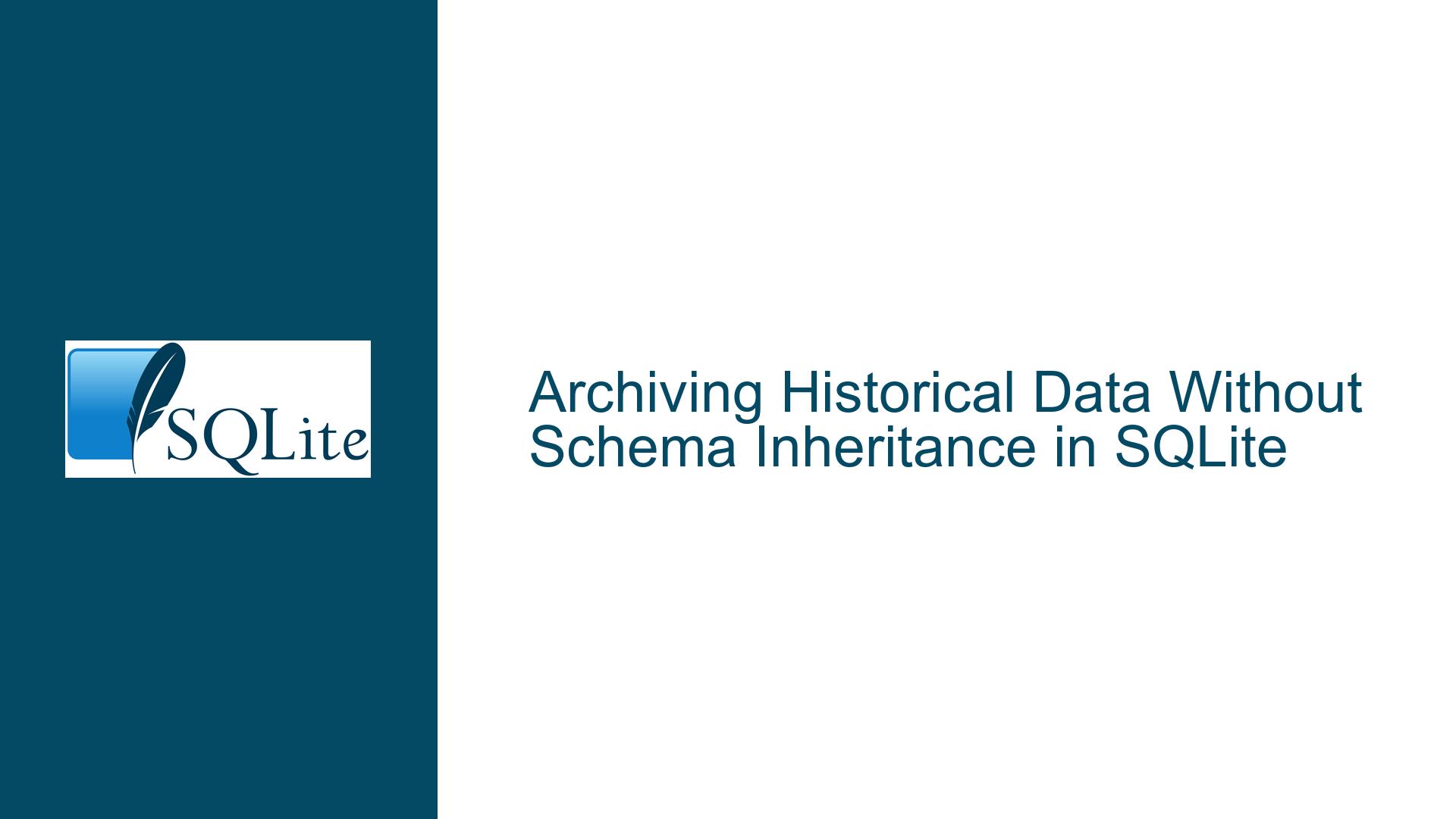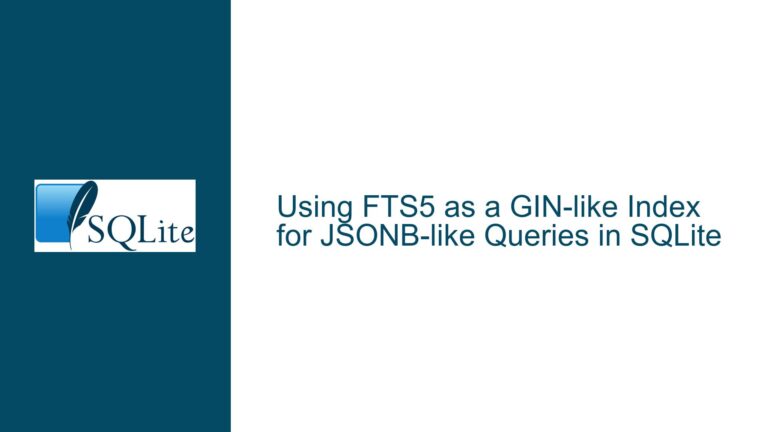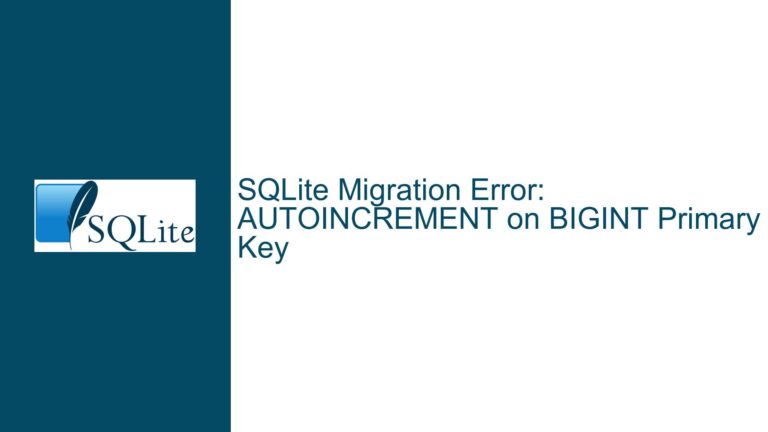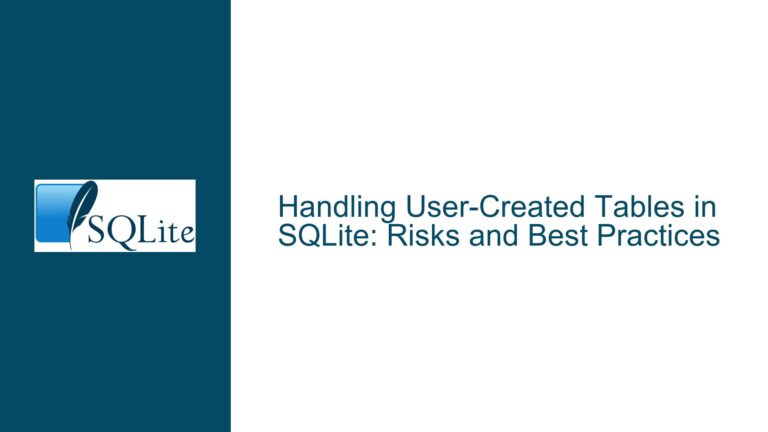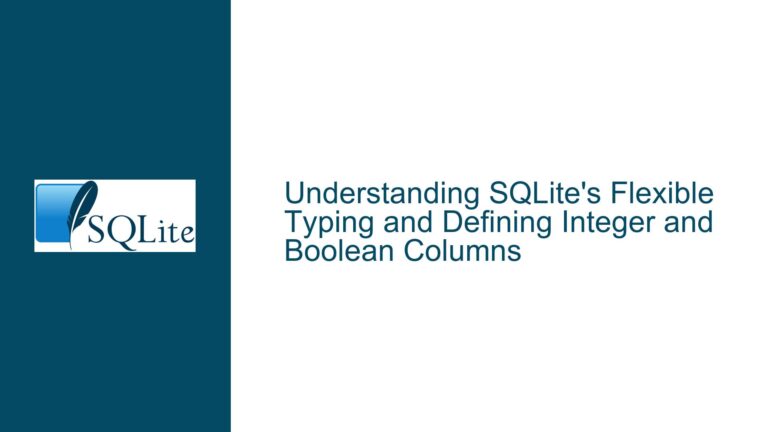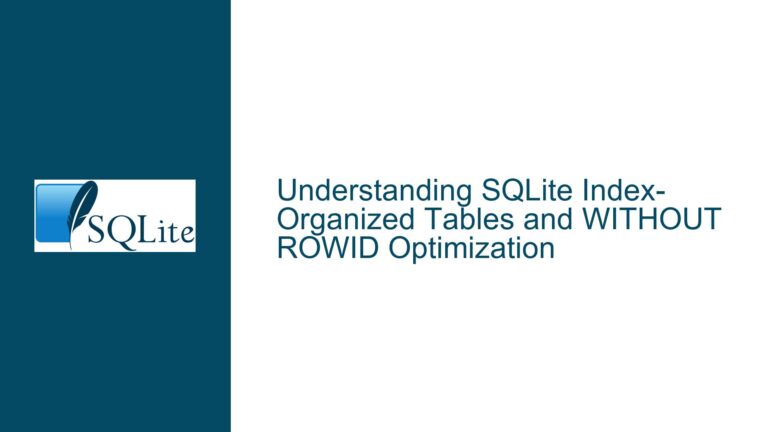Archiving Historical Data Without Schema Inheritance in SQLite
Issue Overview: Moving Historical Data Loses Constraints and Indexes
When attempting to archive historical records from a primary SQLite database into a dedicated history database, a common challenge arises: data migration that excludes critical schema elements such as primary keys, indexes, constraints, and triggers. The original poster (OP) sought to move records older than the current year to a separate database using a process that involved creating a new table in the history database, copying data via INSERT INTO ... SELECT, and deleting the source records. While this approach transfers raw data, it fails to preserve the structural integrity of the original table.
The root of the problem lies in SQLite’s CREATE TABLE AS SELECT (CTAS) command, which creates a new table based on the result set of a query. This method only replicates column names and data types, ignoring all other schema components. For example, if the source table had a UNIQUE constraint on a date column or an index to optimize date-based queries, the destination table in the history database would lack these features. Over time, this omission degrades query performance and compromises data consistency.
A secondary complication involves schema drift—changes to the source table’s structure (e.g., new columns, modified constraints) that occur after the initial archiving process. The OP’s concern about detecting schema changes programmatically highlights the need for a dynamic solution that adapts to evolving table definitions without manual intervention. Without this, yearly archiving scripts risk creating history tables that are structurally incompatible with the source, leading to errors during data migration or analysis.
Possible Causes: Schema Fragmentation and Manual Dependency Management
1. Incomplete Schema Replication
SQLite’s CREATE TABLE statement, when generated implicitly via CTAS, does not include:
- Primary keys: Essential for enforcing row uniqueness and optimizing joins.
- Indexes: Critical for query performance, especially in large datasets.
- Constraints:
CHECK,FOREIGN KEY,UNIQUE, andNOT NULLconstraints ensure data validity. - Triggers: Automated actions tied to data modifications (e.g., audit logs).
- Collations and column affinities: Affects sorting and comparison rules.
Without these elements, the history database becomes a "dumb" copy of the data, unsuitable for complex queries or application integration.
2. Static Schema Assumptions
Archiving scripts often hardcode assumptions about the source table’s structure. For example, the OP’s initial approach used a WHERE clause filtering dates with NOT LIKE '2022-%', which assumes:
- The
datecolumn stores values asTEXTinYYYY-MM-DDformat. - No future changes to the column’s name or data type (e.g., switching to UNIX timestamps).
Such assumptions create brittle workflows. If the source table’s schema evolves—say, a new last_modified column is added—the history table will not automatically inherit this change, causing INSERT operations to fail due to column count mismatches.
3. Transactional Isolation Gaps
The OP’s final script used explicit BEGIN TRANSACTION and COMMIT statements to wrap the INSERT and DELETE operations. However, without proper error handling, interruptions (e.g., power loss) during execution could leave the source and history databases in an inconsistent state. For instance, if the DELETE step fails after a successful INSERT, the source database loses data that was never archived.
Troubleshooting Steps, Solutions & Fixes: Dynamic Schema Extraction and Atomic Workflows
Step 1: Clone the Source Schema Programmatically
To replicate the source table’s full schema in the history database, extract and execute the CREATE statement from the source database’s sqlite_schema table:
# Extract schema for a specific table
sqlite3 source.db ".schema your_table" > schema.sql
# Apply schema to history database
sqlite3 history.db < schema.sql
This ensures all constraints, indexes, and triggers are preserved. For automation, parse the .schema output dynamically in your scripting language of choice (e.g., Python, Bash).
Key Considerations:
- Exclude temporary or system tables by filtering
sqlite_schema.type = 'table'andsqlite_schema.name NOT LIKE 'sqlite_%'. - Handle
WITHOUT ROWIDtables and virtual tables separately.
Step 2: Use Parameterized Date Filtering
Replace brittle LIKE-based date filters with deterministic date arithmetic. For example, if dates are stored as TEXT in ISO8601 format (YYYY-MM-DD):
CURRENT_YEAR=$(date +%Y)
LAST_YEAR=$((CURRENT_YEAR - 1))
WHERE_CLAUSE="WHERE date < '${CURRENT_YEAR}-01-01'"
For UNIX timestamps (stored as INTEGER):
CURRENT_YEAR_START=$(date -d "${CURRENT_YEAR}-01-01" +%s)
WHERE_CLAUSE="WHERE date < ${CURRENT_YEAR_START}"
This approach accommodates future years without manual updates and avoids partial string matches (e.g., 2022-12 matching 2022-123).
Step 3: Atomic Data Transfer with Error Handling
Wrap the archiving operation in a transaction and include error checks to roll back on failure:
sqlite3 history.db <<EOF
ATTACH DATABASE 'source.db' AS source;
BEGIN TRANSACTION;
INSERT INTO main.your_table SELECT * FROM source.your_table ${WHERE_CLAUSE};
DELETE FROM source.your_table ${WHERE_CLAUSE};
COMMIT;
DETACH DATABASE source;
EOF
if [ $? -ne 0 ]; then
echo "Archiving failed. Rolling back changes."
sqlite3 history.db "ROLLBACK;"
exit 1
fi
# Reclaim space in source database
sqlite3 source.db "VACUUM;"
Enhancements:
- Use
SAVEPOINTfor multi-step operations. - Log row counts before and after migration to verify completeness:
SOURCE_ROWS=$(sqlite3 source.db "SELECT COUNT(*) FROM your_table ${WHERE_CLAUSE};") HISTORY_ROWS=$(sqlite3 history.db "SELECT COUNT(*) FROM your_table;") if [ "$SOURCE_ROWS" -ne "$HISTORY_ROWS" ]; then echo "Row count mismatch: $SOURCE_ROWS vs $HISTORY_ROWS" exit 1 fi
Step 4: Schema Versioning and Diff Tools
To detect schema changes between the source and history tables, compare their CREATE statements:
# Extract schema from source
sqlite3 source.db ".schema your_table" > source_schema.sql
# Extract schema from history
sqlite3 history.db ".schema your_table" > history_schema.sql
# Diff schemas
diff source_schema.sql history_schema.sql
Automate this check in your archiving script and trigger alerts on non-empty diffs. For programmatic comparison, use checksums:
SOURCE_SCHEMA_HASH=$(sqlite3 source.db ".schema your_table" | sha256sum)
HISTORY_SCHEMA_HASH=$(sqlite3 history.db ".schema your_table" | sha256sum)
if [ "$SOURCE_SCHEMA_HASH" != "$HISTORY_SCHEMA_HASH" ]; then
echo "Schema drift detected. Update history table definition."
exit 1
fi
Step 5: Handle Schema Drift Automatically
When a schema change is detected, recreate the history table using the updated schema and migrate existing data:
# Backup existing history data
sqlite3 history.db ".backup history_backup.db"
# Drop and recreate table with new schema
sqlite3 history.db <<EOF
DROP TABLE your_table;
$(cat source_schema.sql)
INSERT INTO your_table SELECT * FROM history_backup.your_table;
EOF
Caution: This approach requires downtime. For zero-downtime migrations, use temporary tables or shadow copies.
Step 6: Foreign Key and Dependency Management
If the source table has foreign key relationships, ensure the history database either:
- Includes all referenced tables (impractical for large schemas), or
- Removes foreign key constraints in the history database (if historical data is read-only).
Modify the extracted schema to exclude FOREIGN KEY clauses during history table creation:
sqlite3 source.db ".schema your_table" | sed '/FOREIGN KEY/d' > history_schema.sql
sqlite3 history.db < history_schema.sql
Step 7: Optimize Performance for Large Datasets
For tables with millions of rows, batch the INSERT and DELETE operations to avoid locking the source database for extended periods:
BATCH_SIZE=10000
OFFSET=0
while true; do
sqlite3 history.db <<EOF
ATTACH 'source.db' AS source;
INSERT INTO main.your_table
SELECT * FROM source.your_table
${WHERE_CLAUSE}
LIMIT ${BATCH_SIZE} OFFSET ${OFFSET};
DETACH source;
EOF
ROWS_AFFECTED=$(sqlite3 history.db "SELECT changes();")
if [ "$ROWS_AFFECTED" -eq 0 ]; then
break
fi
OFFSET=$((OFFSET + BATCH_SIZE))
done
# Delete batched records after successful insert
sqlite3 source.db "DELETE FROM your_table ${WHERE_CLAUSE};"
Step 8: Validate Data Consistency
After migration, run integrity checks:
# Check foreign key constraints (if applicable)
sqlite3 history.db "PRAGMA foreign_key_check;"
# Verify no data overlaps remain
sqlite3 source.db "SELECT COUNT(*) FROM your_table ${WHERE_CLAUSE};"
Final Script Example
Combining all steps into a robust Bash script:
#!/bin/bash
set -eo pipefail
SOURCE_DB="general.sqlite"
HISTORY_DB="generalHistory.sqlite"
TABLE="messages"
CURRENT_YEAR=$(date +%Y)
WHERE_CLAUSE="WHERE date < '${CURRENT_YEAR}-01-01'"
# Extract and update schema
SOURCE_SCHEMA=$(sqlite3 "${SOURCE_DB}" ".schema ${TABLE}")
HISTORY_SCHEMA=$(sqlite3 "${HISTORY_DB}" ".schema ${TABLE}" 2>/dev/null || true)
if [ "$SOURCE_SCHEMA" != "$HISTORY_SCHEMA" ]; then
echo "Updating history schema..."
sqlite3 "${HISTORY_DB}" <<EOF
DROP TABLE IF EXISTS ${TABLE};
${SOURCE_SCHEMA}
EOF
fi
# Archive data
sqlite3 "${HISTORY_DB}" <<EOF
ATTACH DATABASE '${SOURCE_DB}' AS source;
BEGIN TRANSACTION;
INSERT INTO main.${TABLE} SELECT * FROM source.${TABLE} ${WHERE_CLAUSE};
DELETE FROM source.${TABLE} ${WHERE_CLAUSE};
COMMIT;
DETACH DATABASE source;
EOF
# Verify counts
SOURCE_COUNT=$(sqlite3 "${SOURCE_DB}" "SELECT COUNT(*) FROM ${TABLE} ${WHERE_CLAUSE};")
HISTORY_COUNT=$(sqlite3 "${HISTORY_DB}" "SELECT COUNT(*) FROM ${TABLE};")
if [ "$SOURCE_COUNT" -ne 0 ]; then
echo "Error: ${SOURCE_COUNT} rows remaining in source."
exit 1
fi
# Reclaim space
sqlite3 "${SOURCE_DB}" "VACUUM;"
echo "Archiving completed successfully."
Notes:
set -eo pipefailensures the script exits on any error.- Schema comparison avoids unnecessary
DROP/CREATEif no changes exist. - Post-migration count verification prevents data loss.
By addressing schema inheritance, transactional safety, and automation, this guide provides a comprehensive solution for annual SQLite data archiving.
